We bet you must have heard it all. Monastic Festivals! Well, here we bring an exquisite introduction to this mystical yet beautiful Buddhist tradition of Ladakh. The monastic festivals are an integral part of the Ladakhi calendar since time immemorial. So much so that in the olden days they served the locals in keeping track of the seasons. Scattered across the year, these festivals occur in most of the gompas that dot the vast barren landscapes of Ladakh.
On a festive day, the local pilgrims throng the monasteries, clad in their best Goncha (traditional Ladakhi dress), jewellery and some even with hand-held prayer wheels. They gather in the spiritual courtyard of the monastery in the wee hours of the day and witness the dance and music of spiritual practices prevalent in the Himalayan regions. The monks play traditional instruments such as drums, conch shells, cymbals and colossal trumpets called Dungchen, while others perform sacred dances known as Chams. The performers wear colourful robes with imposing masks that represent Buddhas, Dharma Guardians and Protectors. A rider while visiting a monastic festival is, unlike any other festival, the general mood of these gatherings is rather spiritual and holy. With this quick orientation, let’s dive into the famed monastic festivals that you could catch-up and experience in Ladakh.
| Festival name | Location | Dates 2026 | Dates 2027 |
|---|---|---|---|
| Spituk Gustor | Spituk Monastery | 16-17 Jan | 05-06 Jan |
| Dosmochey | Leh, Likir, Diskit | 15-16 Feb | 04-05 Feb |
| Stok Guru Tsechu | Stok Palace | 25-26 Feb | 15-16 Feb |
| Matho Nagrang | Matho Monastery | 02-03 Mar | 19-20 Feb |
| Shey Doo Lhoo | Shey Monastery | 18 Mar | 08 Mar |
| Saka Dawa | All over Ladakh | 31 May | 18 Jun |
| Sindhu Darshan | near Shey village | June | June |
| Yuru Kabgyat | Lamayuru Monastery | 13-14 Jun | 01-02 Jul |
| Hemis Tsechu | Hemis Monastery | 24-25 Jun | 13-14 Jul |
| Shachukul Kabgyat | Shachukul Monastery | 02-03 Jul | 20-21 Jul |
| Stongde Gustor | Stongde Monastery | 03-04 Jul | 21-22 Jul |
| Phyang Tserup | Phyang Monastery | 12-13 Jul | 31-01 Aug |
| Karsha Gustor | Karsha Monastery | 12-13 Jul | 31-01 Aug |
| Korzok Gustor | Korzok Monastery | 17-18 Jul | 06-07 Aug |
| Takthok Tsechu | Takthok Monastery | 24-25 Jul | 11-12 Aug |
| Sani Naro Nasjal | Sani Monastery | 28-29 Jul | 16-17 Aug |
| Ladakh Festival | Leh town | 21-24 Sep | 21-24 Sep |
| Diskit Gustor | Diskit Monastery | 08-09 Oct | 27-28 Oct |
| Thiksey Gustor | Thiksey Monastery | 28-29 Oct | 16-17 Nov |
| Chemrey Wangchok | Chemrey Monastery | 07-08 Nov | 26-27 Nov |
| Galdan Namchot | All over Ladakh | 03 Dec | 22 Dec |
| Ladakhi Losar (New Year) | All over Ladakh | 09 Dec | 28 Dec |
Spituk Gustor Festival
The triumph over evil is the underlying theme of all the monastic festivals. Spituk Gustor is held on 28th and 29th of the eleventh month of the Tibetan lunar calendar which falls in the winter. The two-day festival is being celebrated since the 11th century for world peace and harmony at Spituk monastery, which is dedicated to the Gelugpa order of Tibetan Buddhism. It is popular amongst the locals because of the Black Hat dance that enacts the assassination of the notorious Tibetan king (Lang Darma) by a Buddhist monk (Lhalung Pelgyi Dorje) in the early 9th century. The festival progresses with a string of performances themed around Buddhas, their prominent disciples and Gods and Goddesses. Finally, it culminates with the cutting of Torma or the sacrificial cake, thus commemorating the victory of good over evil.
Dosmochey Festival
Dosmochey is the only religious festival that hosts almost all the monasteries of Ladakh. Each year, the monasteries take turn to perform during the festival celebrated at the Leh Palace. On the first day, monks from various monasteries perform sacred traditional mask dances, followed by the offering of ritual cakes (Chotpa) to the Buddhas and their retinue. The monastic adepts of Takthok prepare dho (effigy) to trap evil spirits. They also erect a tall wooden construction, decorated with vibrant threads, called Dosmo. On the second day, both the effigy and Dosmo are ritually burned to chase the evil spirits away. Dosmochey falls on 28th and 29th of the twelfth-month of Tibetan calendar, marking the Tibetan New Year. The festival is also celebrated in Likir and Diskit monasteries.
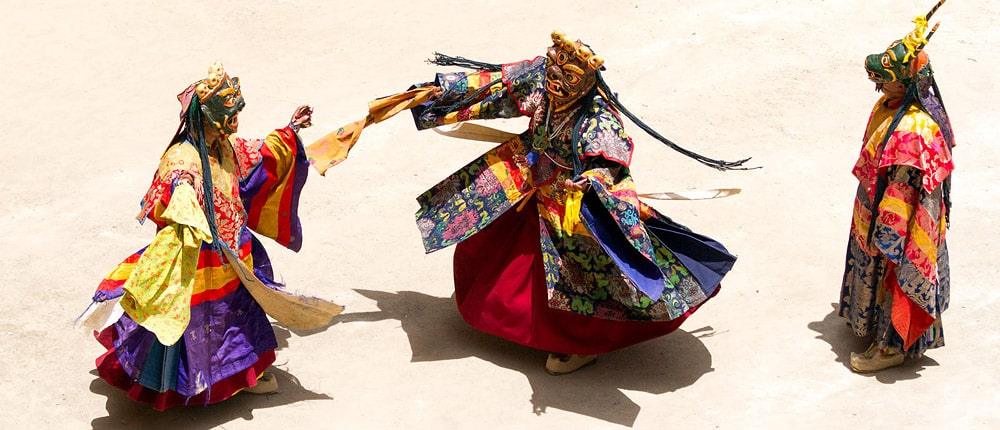
Stok Guru Tsechu Festival
Stok village is located at the other side of Indus River, some 16 km west of Leh. Stok Guru Tsechu is celebrated at the Stok Royal Palace on 9th and 10th of the first month of Tibetan lunar calendar. Here, you will discover two powerful oracles with two laymen as their conduits. The two men get into trance to perform rituals in the courtyard of the monastery. Considering their transcendental experience, the locals and tourists flock at Stok Palace during the festival. The oracles, while performing among other practices and rituals, also reveal premonitions and prophesies. The believers, communities and organizations seek the duo’s advices in order to remove their mundane obstacles and apprehensions.
Matho Nagrang Festival
Matho monastery is the only major establishment in Ladakh dedicated to the Sakya lineage of Tibetan Buddhism. Matho Nagrang, annual spiritual festival of the monastery, is famed across the Himalayan region and beyond. Celebrated on 14th and 15th of the first month of Tibetan lunar calendar, the festival attracts locals, tourists and researchers in hordes. Alike Stok Guru Tsechu, it’s famed for a pair of oracles popularly known as Rongtsans. However, the Rongtsans employ ordained monks as their medium. Every third year, monks are selected as conduits for the oracles. They meditate at least two months in isolation to make themselves conducive for the oracles to transcend in.
On the 14th of the first month, they perform astounding supernatural feats such as running on the roof parapets of the monastery with steep drops of the mountain on which it’s perched, jumping on the corners of the tall monastery walls, cutting themselves with swords and so on. The next day, they display such unbelievable acts completely blindfold. The Rongtsans are also consulted for their clairvoyance and prophecies. Matho Nagrang is definitely one of a kind and shouldn’t be missed if you are in Leh around this time of the year.
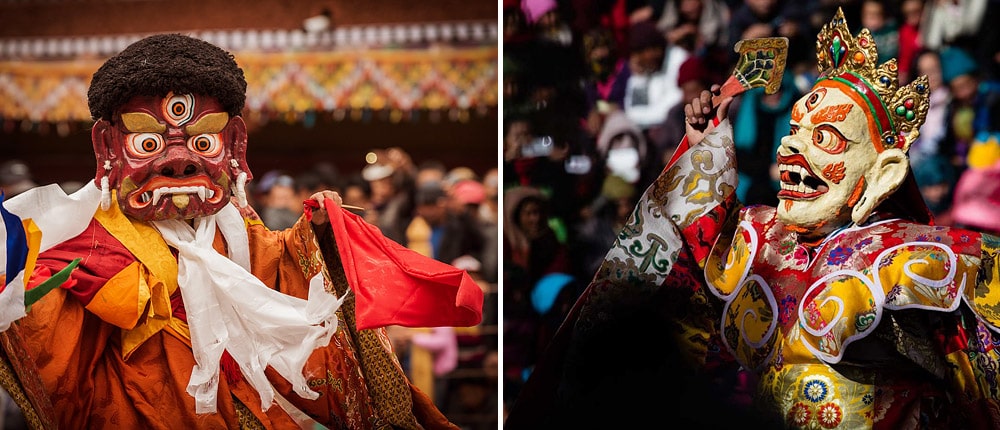
Shey Doo Lhoo Festival
On 29th and 30th of the first month of Tibetan lunar calendar, Shey Doo Lhoo is celebrated at Shey monastery to mark the onset of the sowing season. During the festival, villagers gather at the Shey palace and prepare food. The monks from Hemis monastery pray and bless the villagers for a good harvest. They too have an oracle. The legend has it that there are seven-brother oracles, distributed across different monasteries of Ladakh.
Saka Dawa Festival
The auspicious month ‘Saka Dawa’ is referred to the fourth month of Tibetan lunar calendar. Due to its spiritual significance, it is considered a month to perform virtuous deeds, attain spirituality and purification. Therefore, people hold many spiritual congregations and gatherings. However, the most important day is the full moon day i.e. 15th of the month. Ladakh celebrates it to commemorate Buddha’s birth, enlightenment, and parinirvana (death). The Buddhists engage themselves in performing good karma such as abstaining from meat, giving charity, visiting monasteries, performing rituals and offering prostrations. In Leh, you could enjoy the spectacular day-long procession of Buddha’s Statue and Dharma Scriptures.
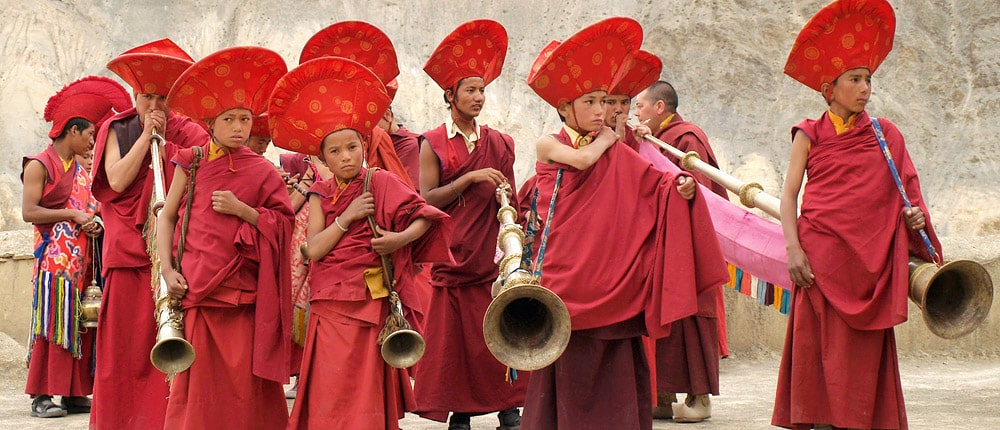
Sindhu Darshan Festival
Sindhu Dharsha is a cultural festival symbolizing India’s identity and civilization. On this day, people from diverse ethnicity and religious groups congregate on one platform to share their culture, tradition and respect for each other. Relatively a new festival, it is observed at the banks of Indus (Sindhu) River at Shey. It begins on the full moon Guru Purnima day and lasts for three or four days depending upon the organizers. The festival includes various religious programs and cultural performances from across the subcontinent.
Hemis Tsechu Festival
One of the must-visit festivals in Ladakh is Hemis Tsechu. It’s a colourful two-day affair that falls on 10th of the fifth month of Tibetan lunar calendar. The occasion celebrates the birth anniversary of Guru Padmasambhava - the founder of Nyingma, the oldest order of Tibetan Buddhism. If you haven’t witnessed any extravagant Cham Performance, then Hemis monastery is the destination to consider. The mask dance represents different figures of god, goddess, dakini and asuras. Particular to this festival, you will witness the performance of Guru Padmasambhava and his eight manifestations. The dancers, adorned aesthetically in silk brocade, perform with musical instruments like drums, cymbals and longhorns. Oh! You cannot miss the display of 22 feet high thangka of Guru Padmasambhava, intricately made with the finest of silk.
Hemis Tsechu festival in 1937
Shachukul Kabgyat Festival
Shachukul (translates as ‘the far-east’) is a village situated 125 km to the east of Leh town and 45 km from Pangong lake. The Shachukul monastery is affiliated to Drikung Kagyu sub-lineage of Kagyu ‘oral transmission’ lineage. Shachukul Kabgyat, held on 17th and 18th of the fifth Tibetan month, is marked by Cham dance of the Buddhas and Dharma protectors of the Drikung Kagyu tradition such as Achi Chokyi Dolma, four-armed Mahakala and others.
Stongde Gustor Festival
Stongde gompa, an ancient monastery in Zanskar valley, is renowned for hosting the Stongde Gustor festival. This monastery, established nearly a millennium ago by Lama Marpa, a disciple of Naropa, serves as the gathering place for both locals and monks. The Stongde Gustor festival takes place on the 28th and 29th days of the 11th month of the Tibetan lunar calendar, featuring sacred mask dances performed by the monks.
Yuru Kabgyat Festival
The annual festival of Lamayuru monastery is popularly known as Yuru Kabgyat. Held on 18th and 19th of the fifth month of Tibetan lunar calendar, it’s dedicated to the Buddhist lord of death and Guru Padmasambhava. If you are wondering about the choreography of the Cham routines, they are based on the ancient Buddhist scriptures. Furthermore, Yuru monastery is situated in the picturesque village renowned as ‘Ladakh’s moonland’, about 115 km south of Leh towards Kargil. You would be treated not only with Yuru Kabgyat, but also be mesmerized by the white mountains of limestones that bestow the place a geological spell.
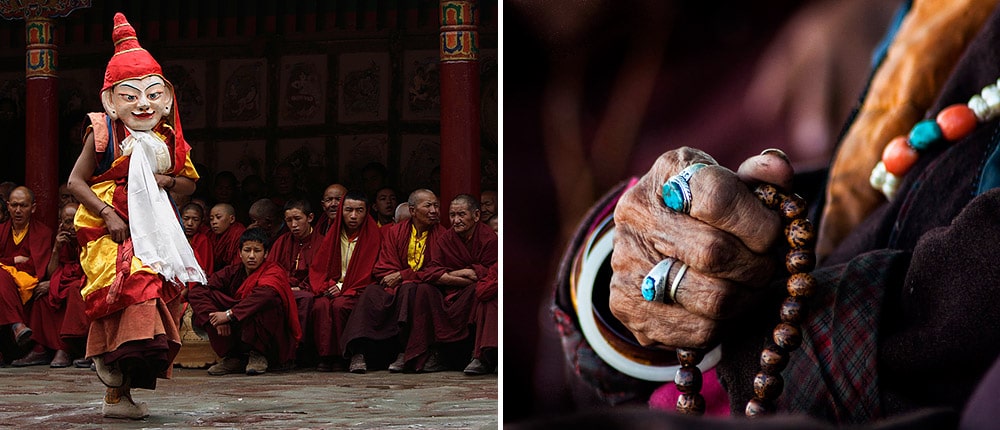
Phyang Tsedup Festival
Drikung Kagyu is one of the sub-lineages within the Kagyu school order of Tibetan Buddhism. Phyang monastery is affiliated to the same. Its festival is called Phyang Tsedup. Dedicated to Skyoba Jigten Gombo, the founder of Drikungpa lineage, it is celebrated on 2nd and 3rd of the sixth month of Tibetan calendar (in July or August). Similar to almost every monastic festival, it illustrates the victory of good over evil. Ritual offerings and burning of effigies are a part of the event. And of course, Cham dance is performed by the monks.
Karsha Gustor Festival
Karsha Gustor Festival is observed at Karsha gompa, which stands as the largest monastery in Zanskar. This festival symbolizes the triumph of good over evil and typically takes place during the summer season. A unique aspect of Karsha Gustor is the prediction of the future, not by renowned oracles or soothsayers, but by a layman. This chosen individual undergoes a process of spiritual purification and preparation conducted by the monastery's monks.
Korzok Gustor Festival
Korzok monastery is located on the shore of the lake Tso Moriri at an altitude of 4,530m in Changthang region. Korzok village belongs to the Changpa nomads of the Changthang plateau that soars above the rest of India in the eastern part of Ladakh. Korzok Gustor attracts nomads from different parts of Changthang. They visit the fair to gain merits and blessings through prayers. Akin to every Gustor celebration, Black Hat dance is performed to mark the killing of Lang Dharma, an apostate king by a Buddhist monk. The festival takes place on 3rd and 4th days of the sixth month of the Tibetan calendar. To know more about the traditional pastoralist lifestyle of nomads, this is the festival to attend.
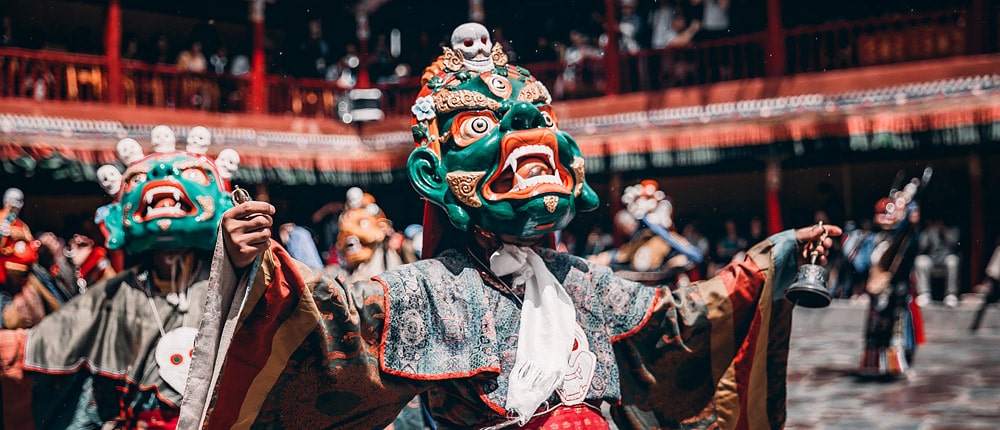
Takthok Tsechu Festival
Takthok (means ‘Rock Roofed Cave’ in Ladakhi language) is a village located near Chemrey, between Leh and Pangong lake. Takthok monastery is one of its kind, the only Nyingma monastery (the oldest spiritual lineage of Tibetan Buddhism) in Ladakh. Guru Padmasambhava, the founder of the Nyingma order, brought the tradition of monastic dance in Tibetan Buddhism. He would dance to subdue obstacles and demons in Tibet during the reign of the King Trisong Detsen. Takthok Tsechu is celebrated on 10th and 11th of the sixth month of Tibetan lunar calendar. During this festival, the monks perform a special Cham called ‘Guru Tsengyat Cham’ - the eight manifestations of Guru Padmasambhava. The masked dance and the presence of these icons are to be experienced first-hand to appreciate them.
Sani Naro Nasjal Festival
Sani monastery has a rich history dating back to the time of the Kanishka Empire in the 1st Century CE, making it the oldest monastery in the Ladakh and Zanskar valley region. Today, it belongs to the Drugpa Kagyu, a sub-lineage within the Kargyu School of Tibetan Buddhism. The monastery hosts its annual festival, known as Sani Naro Nasjal, which takes place between the 15th and 20th days of the sixth Tibetan month. During this festival, monks from Bardan monastery come to Sani, and a statue of the renowned Yogi, Naropa, is unveiled to provide blessings to the local community and pilgrims.
What makes Sani Naro Nasjal unique is that it includes dances performed by newlywed brides from the village. As the festivities conclude, villagers greet and extend their congratulations to the newlyweds, offering them auspicious khataks, traditional ceremonial scarves. Additionally, visitors can witness the blooming of the Guru Naropa flower and explore the historic Kanika Stupa located behind the Sani monastery.
Ladakh Festival
This 4-day long festival is celebrated in September in Leh town. The large scale festival showcases the cultural richness of different communities and tribes of Ladakh. It’s organized by the tourism department to promote Ladakh’s diverse culture, values and tradition and to showcase them for both domestic and foreign tourists. The event includes traditional folk dances and songs, vernacular sports like polo game and archery contests, exhibitions of thangkas and handicrafts, monastic dances, food fest and local Chang (liquor) testing sessions. During the festival, you can also savour organic vegetables and fruits as the harvest season sets in.
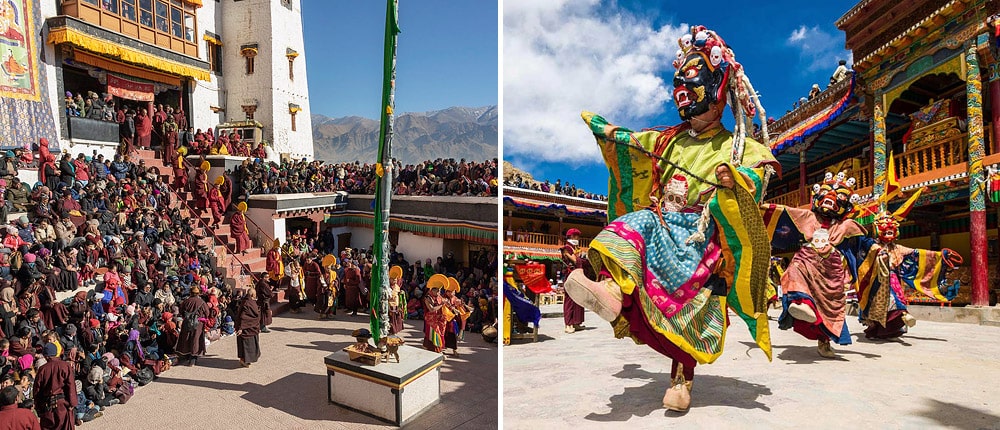
Diskit Gustor Festival
Diskit monastery, situated in the cold desert of Nubra valley, boasts the tallest statue of future Buddha ‘Maitreya’. The monastery is affiliated to Gelug lineage. The annual festival is famously known as Diskit Gustor and held on 28th and 29th of the ninth month of Tibetan lunar calendar. Like every monastic festival, you will see Cham by the resident monks.
Thiksey Gustor Festival
Thiksey monastery is located 20 km to the east of Leh. It is one of the most spectacular, grand and most visited monasteries in the region. Also known as the ‘Mini Potala’ (after H.H the Dalai Lama’s Potala Palace in Tibet), it follows the Gelugpa order founded by Je Tsongkhapa in the 15th century CE. The monastery hosts its annual festival ‘Thiksey Gustor’ on 18th and 19th of the ninth month of Tibetan calendar. It showcases Cham dance, throwing away of dho (effigy) to prevent war, misfortune, physical disaster and epidemic in the world. The Black Hat dance (Shanak Cham) is the central theme. During the festival, the monks also perform kangsol (Puja offerings) for Choskyong (the protectors of the monastery) and khagong as an increment prayer.
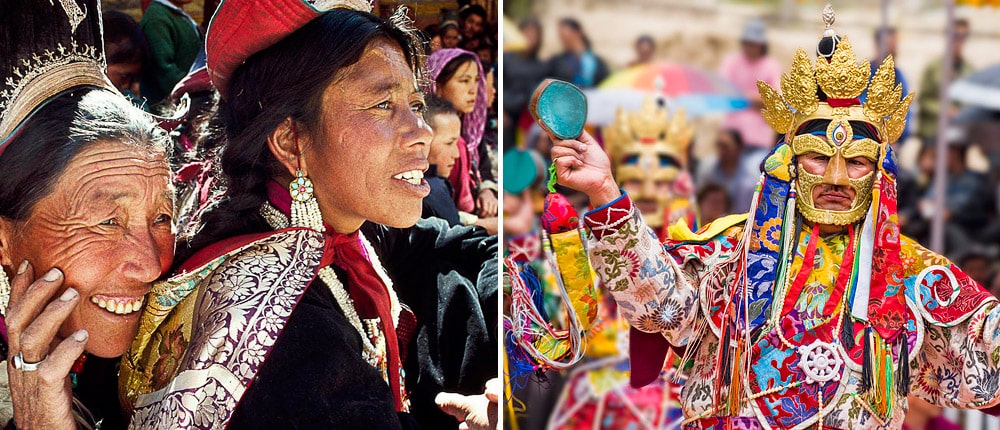
Chemrey Wangchok Festival
Chemrey monastery is one of the oldest spiritual establishments in Ladakh. In 1664 Lama Tagsang Ragspa, the pontiff of the great king Sengge Namgyal, founded Chemrey monastery in the king's memory. It was patronised by the king Deldan Namgyal and Queen Mother Skalzang Dolma, son and wife of Sengge Namgyal. The monastery features a two-storied Guru Padmasambhava statue. Dedicated to the Drukpa lineage of Tibetan Buddhism, the monastery celebrates its festival known as Chemrey Wangchok on the 28th and 29th of the ninth month of the Tibetan calendar. Alike other monasteries, mask dance and spiritual music invoke spirituality and devotion in the audience. Fun fact, the huge structure, perched on an imposing hill in the middle of Chemrey village was a royal fortress before it was converted into a monastery. When you visit the monastery, don't forget to inquire about its secular past as well. It might reveal some interesting wars stories, an indulgence we reserve for another time.
Galdan Namchot Festival
Galdan Namchot or ‘the festival of lights’ is celebrated to commemorate the birth, parinirvana (death) as well as enlightenment of Je Tsongkhapa, the founder of the Gelug order. The festival falls on 25th of the tenth month of Tibetan lunar calendar. On this day, monks light up butter lamps on the corridors, windowsills, altars, and roofs of the monasteries, shrines and temples. Similarly, candles and lamps illuminate the villages after dark. From a distance, the villages and towns glow beautifully in a stream of light, symbolizing the annihilation of darkness. Galdan Namchot ushers New Year celebrations in Ladakh.
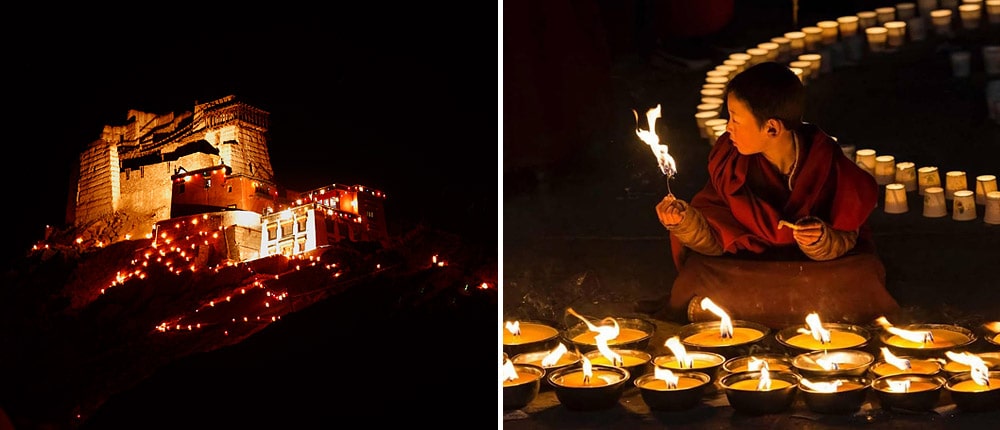
Ladakhi Losar Festival (New Year)
The most awaited festival for the locals is certainly the Losar, the Ladakhi New Year. The festival begins by offering prayers to the Three Jewels (Buddha, Dharma, Sangha) in the monasteries, temples and shrines across Ladakh. It is believed that Losar lasts for 15 days, but the first three days of ten-month of Tibetan calendar are considered utmost important when people visit each other and celebrate.
